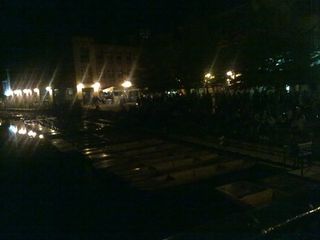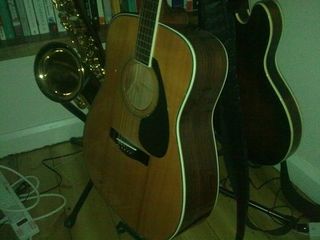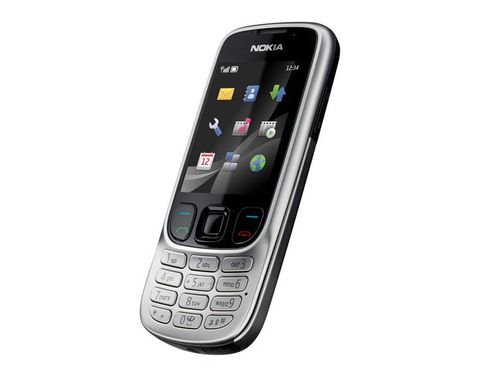Why you can trust TechRadar

It may not have one of Nokia's higher spec sharp-shooting units, but Nokia has equipped the 6303 Classic with a 3.2-megapixel camera featuring autofocus control and an LED flash.
There's no dedicated camera button on the side, but it can be fired up via one of the D-pad shortcuts, or the menus, and is launched and ready to shoot within a couple of seconds.
The viewfinder screen has a default portrait orientation, although what you see in the full screen is what you get, so you can shoot sideways, like a regular camera. You can select a landscape viewfinder configuration, which switches the orientation of softkey settings options, though in practice that's not absolutely necessary.

LIGHT: Shots taken in bright conditions with the 3.2-megapixel camera are crisp, with good detail for this grade of camera, with rich colour and balanced tones
The autofocus system is welcome, but it's not quite the standalone camera or higher range cameraphone type of two-step select-and-then-shoot button pressing. Instead, you fully press and hold the navigation D-pad select button, releasing it to snap the pic when a white focusing frame surrounding your subject turns green.

DETAIL: In strong light the camera can achieve decent levels of detail and deals well with contrast and colour rendition
It's quite rudimentary, as unlike a camera it doesn't allow for you to change your subject focus and readjust if it locks on something in-frame you don't want to be the focal point – once pressed, it'll shoot whether the subject you want is in focus or not.

ZOOM: Zooming in with maximum 8x digital zoom, image quality naturally deteriorates
The limited autofocus system means its more difficult to get satisfactorily composed shots, although at a basic level it does add some facility to get sharper images at different ranges.
Still, it's not great for more ambitious phone photography.

CONTRAST: The camera handles variable lighting pretty well, ensuring the darker portions of the image aren't underexposed
You don't have to use the autofocus, however – you can take quick snaps too, simply by pressing and releasing the button without waiting the second or two for the autofocus to lock on.
Whichever way you use it, the phone takes around five seconds to process the shot before you can get on to the next one – although there's no great shutter lag issues.

GLOOM: In gloomy conditions, the camera still can take OK snaps; here you can read the scoreboard and banners, while the gradation of the cloudy sky isn't bad
The quality of the images using the auto metering system are generally good. Shots taken in bright lighting conditions come out crisp and detailed, with lovely colour reproduction and good contrast.
In murkier conditions, and sometimes indoors in natural light, the system could occasionally get the white balance slightly wrong, adding a cast to images.
We were able to achieve some presentable snaps, though, which were pretty good for a 3.2-megapixel shooter. Close in shots benefit from the autofocus system though you may find you need to have a couple of tries to get it spot on.

FLASH: Over more than a few metres, the LED flash won't offer you much illumination
Indoor shooting was reasonable when light was good, and the flash kicks in when it's gloomier to throw some illumination onto subjects. It's quite bright at close range, and of course it doesn't a fill a room like a high-end xenon flash, but for a cameraphone pitched where the 6303 Classic is, it does the job, enabling you to get viewable results in darker situations.
A 4x digital zoom can be controlled with the D-pad, but as you'd expect, image quality does deteriorate as you zoom in.
Naturally, Nokia has included a stock run down of typical cameraphone effects and settings adjustments – all standard fare for a lower mid-tier phone, set out in a basic Series 40 menu style.

DARK: In dark conditions indoors, the flash offers only limited illumination over a short range and images are murky and noisy
You can override the auto metering system by adjusting white balance and brightness, and also adjust quality and resolution settings. You can also use a timer, engage multi-shot or night mode, or use regular colourisation effects. Post-shooting, a selection of editing tools provides some basic onboard image manipulation options.
Switching to video capture requires a simple sideways D-pad click in the camera. The viewfinder remains in portrait mode, but fills a postbox frame in the middle of the screen. Footage can be recorded at maximum VGA (640x480 pixels) resolution at up to 15 frames per second, so playback looks reasonable for a phone, if a little jittery.
Both still images and video clips can be uploaded to online sites from the handset. Options for uploading to Nokia's Share on Ovi site and Flickr are listed, and apps for both services are pre-loaded into the Applications folder.
Uploading is very straightforward, provided you're signed up to the services, and takes a matter of seconds to get connected. Of course, uploading images or video clips without high-speed data takes longer, so you may have to have patience.
Current page: Nokia 6303 Classic: Camera
Prev Page Nokia 6303 Classic: Internet Next Page Nokia 6303 Classic: Media
